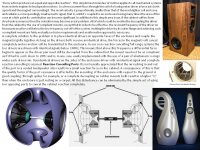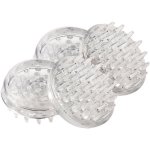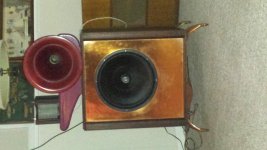I've never had an abode with a wood floor.
The first thing that pops into my head is that you must have a Very nice wood floor and your 'findings' follow what I've found with concrete.
I've always thought this subject to be part of System Synergy.
Concrete may be 'ideal' as a floor*, but even with decent carpet and underlay 'tis cold under-foot
*In my head
The first thing that pops into my head is that you must have a Very nice wood floor and your 'findings' follow what I've found with concrete.
I've always thought this subject to be part of System Synergy.
Concrete may be 'ideal' as a floor*, but even with decent carpet and underlay 'tis cold under-foot
*In my head
Last edited:
There was a PDF by klipsch showing their Heresy's and the disastrous effects of getting it off the concrete floor. A big hole at 200 and 140hz if I remember. All concrete corners helps their speakers have bass in their graphs.
I'd love for someone to re-find it.
Might have been a paper about corner loading.
And yes, sand can help.
A 50lbs bag of sand can do wonders sitting on a certain Vega 3-way speaker.
I use sand in a zip lock bag on horns by the throat.
And yes, the effects vary depending on build quality.
I'd love for someone to re-find it.
Might have been a paper about corner loading.
And yes, sand can help.
A 50lbs bag of sand can do wonders sitting on a certain Vega 3-way speaker.
I use sand in a zip lock bag on horns by the throat.
And yes, the effects vary depending on build quality.
I have installed 5 vibration dampers for (usually) industrial use on my speakers. Each damper has a specified max load of 9 kg and the speaker weighs 44,5 kg, so about as close to optimal as one can get.
When loaded to its specified max value, the vibration damper reaches its lowest possible natural resonance. (In my case about 14 Hz.) This means the vibration dampers (and the supported cabinet) are in a "floated" condition and will isolate vibrations from and to the cabinet from 14 x (root 2) = about 24 Hz and upwards. If the speaker can play lower than 24 Hz, those frequencys will actually be amplified and transmitted to the room structure. Worst case will be at the resonance frequency 14 Hz. A lower load will render a higher natural resonance frequency and worse isolation frequency wise, as the rubber gets "stiffer" versus a lower load. Too high a load and the rubber "bottoms out" and the isolation performance gets worse too. So optimal load is important for best performance. Like: If too low a load gives a natural resonance at 30 Hz, all frequencies below 42 Hz will be amplified and transmitted to the room structure. Good or bad ?
(So no, I do not believe metal spikes giving a stiff, rigid connection to surrounding structure are the best solution, if you do not want the room structure to rattle along. This may mean a less rich bass is felt when say 25 m² / 269 ft² of wooden floor don't vibrate along with the bass driver and the cabinet, but for more balanced bass I prefer some additional subs.)
Pictures of the dampers and some diagrams on similar ones for higher max load.
I wonder why everyone has been ignoring this post. Is this solution actually better or worse than conventional spike method (in theory)?
The theory (to avoid transmitting vibrations directly from the source to surfaces in contact with it) is about the same for, let say, a laundry machine. Your laundry machine is probably standing on rubber feet or metallic springs with properties chosen versus its weight and rpm-value when it centrifugates. When it starts from 0 rpm and goes upwards in speed during centrifugation, it enters an "area" where it wobbles and rattles quite violently, = at or close to the feet resonance, then as rpm speeds up further the machine stabilizes and becomes quite still and its vibrations are not transmitted through the feet to the floor. It is about the same for a car engine, it is not firmly attached to the car body by stiff bolts or welded to it, some kind of rubber grommets are used. (Now, if you like the sound from a wooden floor vibrating and playing along with resonances, due to stiff coupling to the speaker, that is another thing.)
Last edited:
There was a PDF by Klipsch showing their Heresy's and the disastrous effects of getting it off the concrete floor. A big hole at 200 and 140hz if I remember. All concrete corners helps their speakers have bass in their graphs.
I'd love for someone to re-find it.
Might have been a paper about corner loading.
Indeed. The PWK article on corner speaker placement including a discussion of the preferred angular width of the front speakers...note that the captions on figures 1 and 2 are inverted: Corner Speaker Placement - PWK.pdf
Chris
Philosophy: minimize cabinet vibration to minimize floor interface effects
The engineers at Vivid use Reaction Cancelling on the woofers with a side-side counter-force canceling cabinet. An "O-Ring" is used to isolate each speaker from the cabinet. The side-side woof-woof use a screw-force connected to each rear magnet to pull the drivers into the cabinet O-ring. The tweet and mid use a long screw rod from the rear of the tapered tube to pull the drivers into the cabinet O-ring.
=========
I use a few ~0.25" thick neoprene rubber squares to to isolate my speakers on hard floors. On capeted floors I glue together two 0.75" MDF boards which just match the speaker base shape, and add the neoprene rubber squares between the speaker and this (black) MDF base.
Measurement data shows that Sorbothane has better vibration absorption than neoprene, but is much more expensive than old mouse pads.
I would get "staked" if I attempted to spike mount a speaker on our home floors.
The engineers at Vivid use Reaction Cancelling on the woofers with a side-side counter-force canceling cabinet. An "O-Ring" is used to isolate each speaker from the cabinet. The side-side woof-woof use a screw-force connected to each rear magnet to pull the drivers into the cabinet O-ring. The tweet and mid use a long screw rod from the rear of the tapered tube to pull the drivers into the cabinet O-ring.
=========
I use a few ~0.25" thick neoprene rubber squares to to isolate my speakers on hard floors. On capeted floors I glue together two 0.75" MDF boards which just match the speaker base shape, and add the neoprene rubber squares between the speaker and this (black) MDF base.
Measurement data shows that Sorbothane has better vibration absorption than neoprene, but is much more expensive than old mouse pads.
I would get "staked" if I attempted to spike mount a speaker on our home floors.
Attachments
Last edited:
Force cancellation by using opposing woofers is a perfect solution. My mltl prototype uses only one driver atm and is top mounted. Even with spikes the overall mass of the enclosure et al is not enough to prevent it from moving vertically even if resting on concrete. Amazing how much force is generated by a little 14gram cone reproducing an A note 
Isolation by using dampeners must be optimized as mentioned above, and is excellent advise.
Isolation by using dampeners must be optimized as mentioned above, and is excellent advise.

I have 4 rubber pads (I cut in an industrial rubber 1cm layer for industrial Tools and washing-machine vibration cancelation) ! the 4 rubers pads are on a true parquet floor (which works a little as woofer driver when the speaker is directly coupled on it, even with spikes !)!
On the ruber pads I putted a medium 2.5 cm layer then my speakers on it (which have 4 metal flat round feets (brand speakers genuine screwed feets)
Bass are better than with spikes directly coupled on the parquet
medium has a better clearness/definition (mid & treble from 125 Hz are aluminium drivers)
softness is improved !
I used try & error method.
Speakers are 38 Kg each, 35 Hz F3. band pass load to 125 Hz !
On the ruber pads I putted a medium 2.5 cm layer then my speakers on it (which have 4 metal flat round feets (brand speakers genuine screwed feets)
Bass are better than with spikes directly coupled on the parquet
medium has a better clearness/definition (mid & treble from 125 Hz are aluminium drivers)
softness is improved !
I used try & error method.
Speakers are 38 Kg each, 35 Hz F3. band pass load to 125 Hz !
Btw, the ball with cancelation speaker and oposite double- nozzle like shape is very cool !
A speaker brand (Haliaetus) launched a double nozzle event port which was mathematicly the best model for bass reflex to cancell vibration around the events and prevent for distorsion in the bass Fhz areas (mechanical constraint on the air output through an event shape)!
Jean-Pierre Morkerken, Benjamin Parzy, Guillaume Pellerin et Jean-Dominique Polack, « Vented-box Geometry and Low Frequency Reproduction: The Aerodynamical Approach », AES Convention, no 112
Mario Rossi, Audio, Lausanne, Presses Polytechniques et Universitaires Romandes, 2007, 1e éd. (ISBN978-2-88074-653-7), p. 567 sq « 9.2.28 Système à enceinte ouverte à évent »
La tuyère acoustique donne un nouveau souffle à la hi-fi
vortex sound cancelation + vibration cancelation is certainly a must when it comes to BR load or band pass load.
A speaker brand (Haliaetus) launched a double nozzle event port which was mathematicly the best model for bass reflex to cancell vibration around the events and prevent for distorsion in the bass Fhz areas (mechanical constraint on the air output through an event shape)!
Jean-Pierre Morkerken, Benjamin Parzy, Guillaume Pellerin et Jean-Dominique Polack, « Vented-box Geometry and Low Frequency Reproduction: The Aerodynamical Approach », AES Convention, no 112
Mario Rossi, Audio, Lausanne, Presses Polytechniques et Universitaires Romandes, 2007, 1e éd. (ISBN978-2-88074-653-7), p. 567 sq « 9.2.28 Système à enceinte ouverte à évent »
La tuyère acoustique donne un nouveau souffle à la hi-fi
vortex sound cancelation + vibration cancelation is certainly a must when it comes to BR load or band pass load.
Last edited:
I do love the industrial damping feet I use on my "two towers".

I've had a "poor man's spikes" solution before switching to these and the gain in decoupling of these damping feet was very noticeable.
A testament of their effectiveness can be read here: http://www.diyaudio.com/forums/full-range/242171-making-two-towers-25-driver-full-range-line-array-275.html#post4905160
A 'snipped' quote:

I've had a "poor man's spikes" solution before switching to these and the gain in decoupling of these damping feet was very noticeable.
A testament of their effectiveness can be read here: http://www.diyaudio.com/forums/full-range/242171-making-two-towers-25-driver-full-range-line-array-275.html#post4905160
A 'snipped' quote:
Oh, the cabinets themselves are very impressive. I put my ear to the side while they were playing and could not hear or feel any vibrations or sound. Just inert. The hand cut and polished aluminum bezel waveguide is also quite the piece of workmanship.
Another thing I noticed is how rigidly the driver baskets are coupled to the baffle. Ideally the driver cones are suspended on a perfectly immobile rigid struct, however still capable of dissipating the reaction force generated on the basket when the cone moves.
Due to DIY obsession, frequent mounting and removal of drivers from MDF baffle can make the screw holes loose and mess with how rigidly the driver baskets couple to the baffle. Any proposals to restore/fix these deteriorated driver mounting holes?
Due to DIY obsession, frequent mounting and removal of drivers from MDF baffle can make the screw holes loose and mess with how rigidly the driver baskets couple to the baffle. Any proposals to restore/fix these deteriorated driver mounting holes?
"Spiked Caster Cups" is one common name for the 1.5" - 3" diameter clear plastic furniture leg-cups with several plastic spikes on the bottom which lift furniture without crunch-down damage to the carpet. I suspect there are many clever ways to shock mount "Spiked Caster Cups" on the bottom of speakers. These might be more family-home acceptable than the large steel spikes on many heavy speakers.
The soft plastic would be easy to machine, and a belt sander or grinder wheel should easily remove the rim around the cup and leave a flat plastic puck with plastic spikes which can be screwed or shock mounted to the bottom of a cabinet.
The soft plastic would be easy to machine, and a belt sander or grinder wheel should easily remove the rim around the cup and leave a flat plastic puck with plastic spikes which can be screwed or shock mounted to the bottom of a cabinet.
Attachments
btw whats the conclusion here?
1. Spikes for rigid coupling to hardfloor
or
2 Sorbathanw/Rubber isolators for vibration damped coupling to floor?
I think spikes still remain in main stream, but people here start discovering those industrial damping feet.
I got mine from a company that sells Machinery vibration damping foot mounts. Googling on that should provide plenty results.
Thanks!
Plasnu; to get the right kind of feet, you need to first weigh your speakers. Divide the weight with the numbers of feet you plan to use. A vibration damper with a thread is easier to use than one with a fixed, flat flange (the kind I used). With a fixed flange, you need to find the centre of gravity for the box. In the picture from my post which you quoted, you can see that the damper in the middle is slightly off centre on the speakers foot print, as it was placed at the centre of gravity between front and back (below the magnet).
The vibration dampers get compressed somewhere between 3-5 mm, to reach that "floating" condition. With a threaded damper you can adjust any imbalance so the speker does not lean forward/backwards. As said, the closer you can load the vibration dampers to their max value, the lower in frequency you reach with your isolation. (This also means the speakers will sway easily if you give them the slightest push.)
The vibration dampers get compressed somewhere between 3-5 mm, to reach that "floating" condition. With a threaded damper you can adjust any imbalance so the speker does not lean forward/backwards. As said, the closer you can load the vibration dampers to their max value, the lower in frequency you reach with your isolation. (This also means the speakers will sway easily if you give them the slightest push.)
- Status
- This old topic is closed. If you want to reopen this topic, contact a moderator using the "Report Post" button.
- Home
- Loudspeakers
- Multi-Way
- Cabinet and floor coupling : sound behaviors...


